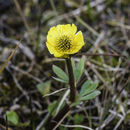Description
provided by eFloras
Stems erect from short caudices, 4-22 cm, glabrous or sparsely pilose, each with 1 flower. Roots slender, 0.4-0.8 mm thick. Basal leaves persistent or deciduous, blades reniform, 3-parted, 0.6-2 × 1.3-3 cm, at least lateral segments again lobed or margins toothed, base truncate or cordate, apices of segments rounded-apiculate. Flowers: pedicels glabrous or brown-pilose; receptacle glabrous; sepals 6-8 × 3-5 mm, abaxially densely brown-hispid; petals 5(-6), 8-11 × 7-12 mm; nectary scale glabrous. Heads of achenes cylindric or ovoid-cylindric, 7-14 × 5-6 mm; achenes 1.5-2.2 × 1.2-1.6 mm, glabrous; beak slender, straight, 1-2 mm. 2 n = 48.
- license
- cc-by-nc-sa-3.0
- copyright
- Missouri Botanical Garden, 4344 Shaw Boulevard, St. Louis, MO, 63110 USA
Distribution
provided by eFloras
Greenland; Alta., B.C., Nfld., N.W.T., Que., Yukon; Alaska; Eurasia.
- license
- cc-by-nc-sa-3.0
- copyright
- Missouri Botanical Garden, 4344 Shaw Boulevard, St. Louis, MO, 63110 USA
Flowering/Fruiting
provided by eFloras
Flowering late spring-summer (Jun-Aug).
- license
- cc-by-nc-sa-3.0
- copyright
- Missouri Botanical Garden, 4344 Shaw Boulevard, St. Louis, MO, 63110 USA
Habitat
provided by eFloras
Wet or dry alpine meadows, often around late snowbeds, cliffs, and streamsides; 0-1300m.
- license
- cc-by-nc-sa-3.0
- copyright
- Missouri Botanical Garden, 4344 Shaw Boulevard, St. Louis, MO, 63110 USA
Ranunculus nivalis: Brief Summary
provided by wikipedia EN
Ranunculus nivalis, the snow buttercup, is a species of plant in the family Ranunculaceae. It is a perennial herb that grows up to 9 in (23 cm). It grows in wet alpine meadows, cliffs and streamsides. It displays prevalent heliotropism, thus gaining an advantage in its harsh, cold environment through capturing more solar energy by following the sun.
- license
- cc-by-sa-3.0
- copyright
- Wikipedia authors and editors

